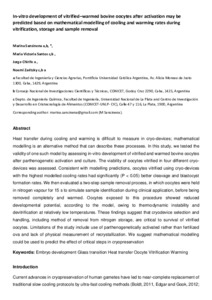Please use this identifier to cite or link to this item:
https://repositorio.uca.edu.ar/handle/123456789/9493| Título: | In-vitro development of vitrified-warmed bovine oocytes after activation may be predicted based on mathematical modelling of cooling and warming rates during vitrification, storage and sample removal | Autor: | Sansiñena, Marina Julia Santos, María Victoria Chirife, Jorge Zaritzky, Noemí |
Palabras clave: | FERTILIZACION IN VITRO; TRANSFERENCIA DE CALOR; DESARROLLO EMBRIONARIO; CRIOPRESERVACION; VITRIFICACION; OVOCITOS; BOVINOS | Fecha de publicación: | 2018 | Editorial: | Elsevier | Cita: | Sansiñena,M.J. et. al. In-vitro development of vitrified-warmed bovine oocytes after activation may be predicted based on mathematical modelling of cooling and warming rates during vitrification, storage and sample removal [en línea]. Reproductive BioMedicine. 2018, 36(5). doi:10.1016/j.rbmo.2018.01.003 Disponible en: https://repositorio.uca.edu.ar/handle/123456789/9493 | Resumen: | Abstract: Heat transfer during cooling and warming is difficult to measure in cryo-devices; mathematical modelling is an alternative method that can describe these processes. In this study, we tested the validity of one such model by assessing in-vitro development of vitrified and warmed bovine oocytes after parthenogenetic activation and culture. The viability of oocytes vitrified in four different cryo-devices was assessed. Consistent with modelling predictions, oocytes vitrified using cryo-devices with the highest modelled cooling rates had significantly (P < 0.05) better cleavage and blastocyst formation rates. We then evaluated a two-step sample removal process, in which oocytes were held in nitrogen vapour for 15 s to simulate sample identification during clinical application, before being removed completely and warmed. Oocytes exposed to this procedure showed reduced developmental potential, according to the model, owing to thermodynamic instability and devitrification at relatively low temperatures. These findings suggest that cryo-device selection and handling, including method of removal from nitrogen storage, are critical to survival of vitrified oocytes. Limitations of the study include use of parthenogenetically activated rather than fertilized ova and lack of physical measurement of recrystallization. We suggest mathematical modelling could be used to predict the effect of critical steps in cryopreservation. | URI: | https://repositorio.uca.edu.ar/handle/123456789/9493 | ISSN: | 1472-6483 (impreso) 1472-6491 (online) |
Disciplina: | CIENCIAS AGRARIAS | DOI: | 10.1016/j.rbmo.2018.01.003 | Derechos: | Acceso abierto | Fuente: | Reproductive BioMedicine. 2018, 36(5) |
| Appears in Collections: | Artículos |
Files in This Item:
| File | Description | Size | Format | |
|---|---|---|---|---|
| In-vitro-development-viitrified.pdf | 741,22 kB | Adobe PDF |  View/Open |
Page view(s)
284
checked on Nov 28, 2025
Download(s)
275
checked on Nov 28, 2025
Google ScholarTM
Check
Altmetric
Altmetric
This item is licensed under a Creative Commons License

